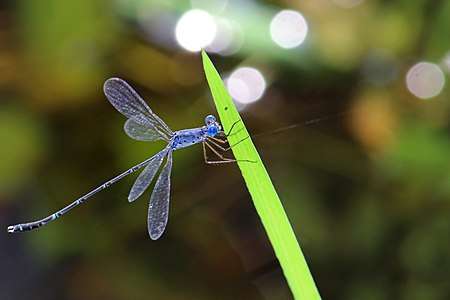Lestes praemorsus
Lestes praemorsus[3][1] is a damselfly species in the family Lestidae. It is commonly known as the scalloped spreadwing or sapphire-eyed spreadwing.[4][5] It is very widely distributed from India to China and south to New Guinea.[1][6]
| Scalloped spreadwing | |
|---|---|
 | |
| male | |
| Scientific classification | |
| Kingdom: | |
| Phylum: | |
| Class: | |
| Order: | |
| Family: | |
| Genus: | |
| Species: | L. praemorsus |
| Binomial name | |
| Lestes praemorsus Hagen in Selys, 1862 | |
| Synonyms | |
| |
Description and habitat
It is a medium-sized damselfly with the male have an abdomen length 32 to 35 mm compared to the similar looking species, Lestes dorothea having an abdomen length 36–40 mm. Its head is black and matured males have deep sapphire-blue eyes as in L. dorothea. Its thorax is black, pruinosed white laterally, yellowish beneath. The dorsum of the thorax is marked with a pair of metallic green antehumeral stripes shaped like those seen in L. dorothea. There are several irregular spots present on both sides. The thorax of matured males are heavily pruinosed, obscuring all these markings. Abdomen is blue marked with black on dorsum. Segments 2 to 7 have very narrow bluish basal rings. Segment 8 has a thin apico-lateral blue spot. Segment 9 has a very large lateral spot of blue on each side which may get pruinosed to form an apical ring in adults. Segment 10 also has a blue spot on each side, get pruinosed to form an apical ring in adults. Anal appendages are pale yellow with black on apices. Female is similar to the male with pale yellowish green colors.[7]
It breeds in well vegetated ponds, marshes and lakes. This damselfly can be found quite commonly in shaded lowland swamps and drains.[7][8][9][4][5]
See also
- List of odonates of India
- List of odonata of Kerala
References
- Sharma, G. & Dow, R.A. (2010). "Lestes praemorsus". IUCN Red List of Threatened Species. 2010: e.T167485A6356018.CS1 maint: uses authors parameter (link)
- Kirby, William Forsell (1894). "Catalogue of the described Neuroptera Odonata (Dragonflies) of Ceylon, with descriptions of new species". The Journal of the Linnean Society of London. 24: 565–566. Retrieved 17 October 2018.
- Martin Schorr; Dennis Paulson. "World Odonata List". University of Puget Sound. Retrieved 12 Oct 2018.
- "Lestes praemorsus Hagen in Selys, 1862". India Biodiversity Portal. Retrieved 2017-03-09.
- "Lestes praemorsus Hagen in Selys, 1862". Odonata of India, v. 1.00. Indian Foundation for Butterflies. Retrieved 2017-03-09.
- K.A., Subramanian; K.G., Emiliyamma; R., Babu; C., Radhakrishnan; S.S., Talmale (2018). Atlas of Odonata (Insecta) of the Western Ghats, India. Zoological Survey of India. pp. 43–44. ISBN 9788181714954.
- C FC Lt. Fraser (1933). The Fauna of British India, including Ceylon and Burma, Odonata Vol. I. Red Lion Court, Fleet Street, London: Taylor and Francis. pp. 30–33.
- C FC Lt. Fraser (1924). A Survey of the Odonate (Dragonfly) Fauna of Western India with Special Remarks on the Genera Macromia and Idionyx and Descriptions of Thirty New Species (PDF). Zoological Survey of India. Volumes (Records). p. 486.
- Subramanian, K. A. (2005). Dragonflies and Damselflies of Peninsular India - A Field Guide.
External links
![]()
![]()
